Looking for some spine-tingling humor to celebrate Día de los Muertos? We’ve gathered the funniest Day of the Dead jokes that strike the perfect balance between respectful and hilarious. These skeleton-themed quips are guaranteed to tickle your funny bone!
While Day of the Dead is a time for honoring departed loved ones, the celebration embraces joy and laughter alongside remembrance. We believe humor can be a meaningful part of this colorful Mexican tradition. Our collection of jokes adds a light-hearted touch to your festivities without diminishing the cultural significance of this important holiday.
10 Hilariously Spooky Day of the Dead Jokes That Will Make Your Spirits Rise
- Why don’t skeletons fight each other? They don’t have the guts! During Day of the Dead celebrations, these bony characters are everywhere, but thankfully they keep the peace.
- What’s a skeleton’s favorite musical instrument? The trom-BONE! Many Day of the Dead festivities include music and dancing, with skeletons often depicted playing instruments.
- How do skeletons call their friends? On their cell phones! Even though being ancient traditions, we’ve noticed modern Day of the Dead decorations sometimes include skeletons with contemporary items.
- What do you call a skeleton who won’t work? Lazy bones! In Day of the Dead artwork, skeletons are usually shown being quite active, captivating in everyday activities their living counterparts enjoyed.
- Why didn’t the skeleton go to the party? He had no body to go with! Ironically, during Día de los Muertos, skeletons are the life of the party as they’re represented celebrating with the living.
- What did the skeleton say before eating dinner? Bone appetit! Food offerings are central to Day of the Dead traditions, with favorite meals prepared for departed loved ones.
- How do skeletons send messages? Through the skull mail! Communication between the living and dead is a key concept during the Day of the Dead, when the veil between worlds thins.
- What’s a skeleton’s favorite snack? RIBS! Sweet bread shaped like bones (pan de muerto) is actually a traditional treat during Day of the Dead celebrations.
- Why don’t skeletons like winter? The cold goes right through them! Day of the Dead occurs at the beginning of November, fortunately before the coldest weather arrives.
- What do you call a skeleton who tells silly jokes? A funny bone! Humor is embraced during Day of the Dead, with calaveras literarias (literary skulls) often featuring playful, satirical poems about friends and family.
Skeleton Jokes That Will Tickle Your Funny Bone
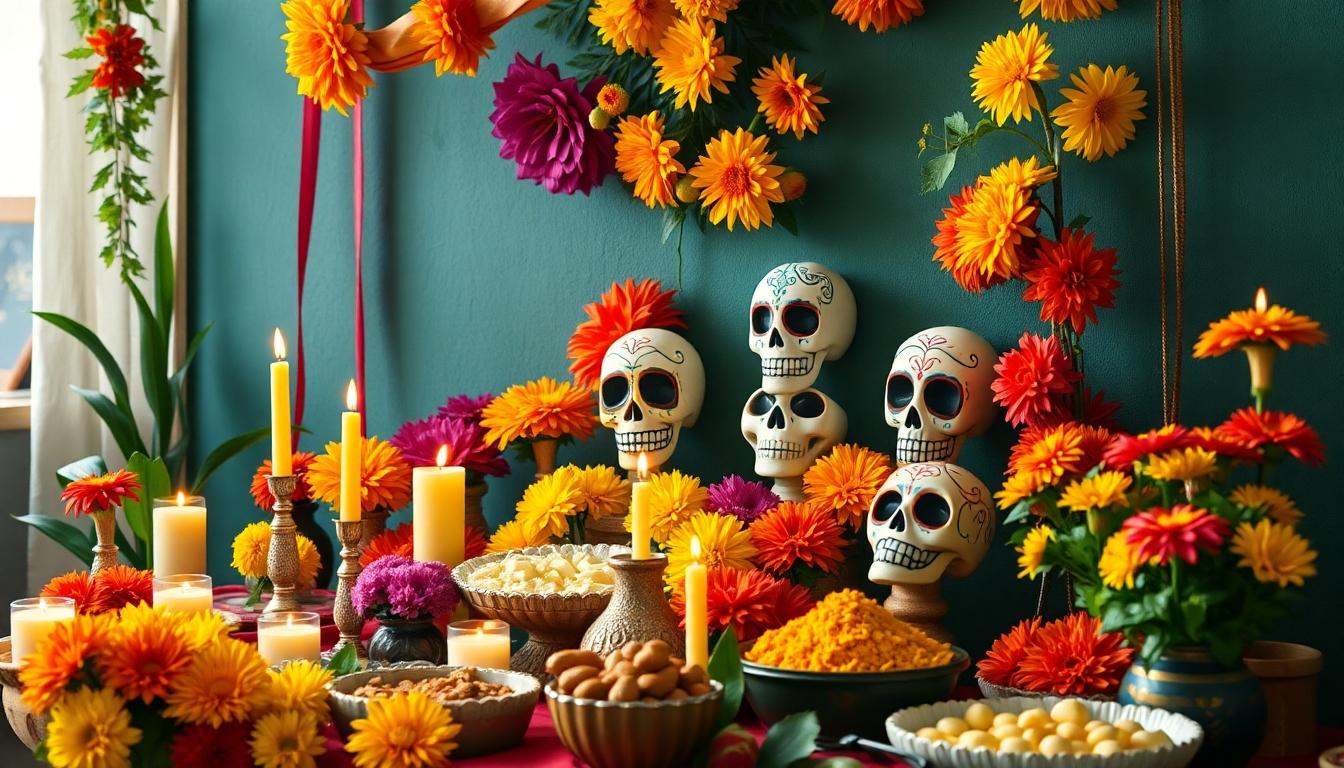
Day of the Dead celebrations beautifully balance reverence with revelry, and skeleton jokes play a central role in this cultural fusion. These bone-themed punchlines incorporate traditional calavera imagery while honoring the holiday’s approach to mortality through humor.
Ribcage Rippers
Skeleton jokes during Día de los Muertos often reflect the celebration’s playful approach to remembering loved ones. “Why did the skeleton go to the Day of the Dead party? To have a bone-afide good time” perfectly captures the festive spirit while incorporating the skeleton imagery central to the holiday. These jokes mirror traditional calavera artwork that whimsically portrays death through animated skeletons.
Musical references frequently appear in Day of the Dead humor, connecting two essential elements of the celebration. “What’s a skeleton’s favorite instrument on Day of the Dead? A mariachi-phone” cleverly combines traditional mariachi music with bone-related wordplay. Such jokes reinforce the cultural significance of music during these celebrations while maintaining the lighthearted tone that characterizes the holiday’s approach to mortality.
Skull-Splitting One-Liners
Food-themed skeleton jokes tie directly into the feast traditions of Día de los Muertos. “What does a skeleton order at a restaurant? Spare ribs” references both skeletal anatomy and the important role food plays in honoring deceased loved ones during the celebration. Families typically prepare special dishes to place on ofrendas (altars), making food-centric humor particularly resonant.
Jokes about skeletons’ temperaments often highlight their unflappable nature. “Why are skeletons so calm? Nothing gets under their skin” leverages anatomical humor while reflecting the holiday’s peaceful acceptance of death. This calm approach mirrors how Day of the Dead celebrations view mortality—not as something frightening but as a natural part of existence worth commemorating with joy and respect.
Common skeleton jokes like “Why didn’t the skeleton go to the dance? He had no body to go with him” reflect themes of absence and memory that resonate deeply with the holiday’s purpose. The linguistic playfulness seen in jokes such as “How do French skeletons say hello? Bone-jour!” demonstrates how skeleton humor transcends cultural boundaries while maintaining its connection to the celebration of life through remembrance.
Afterlife Humor: Day of the Dead Puns That Are Deadly Funny
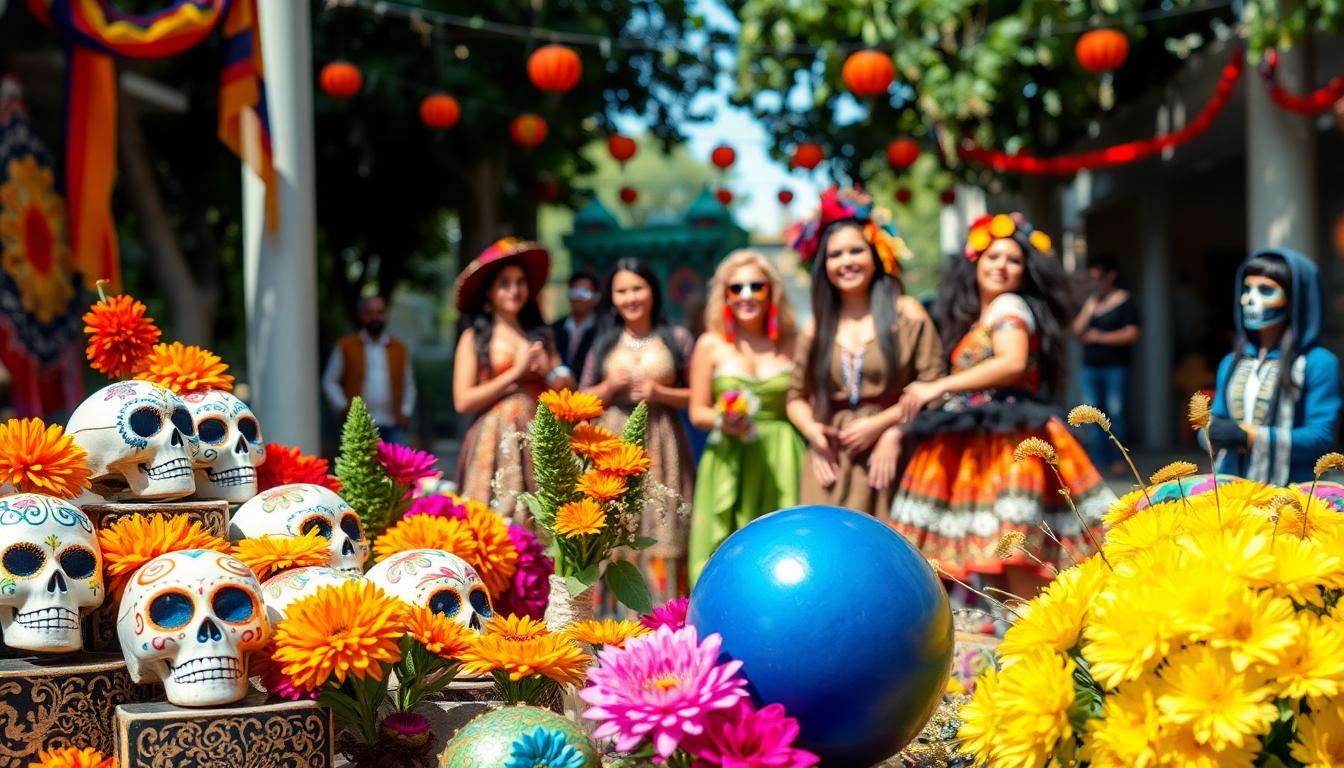
Day of the Dead (Día de los Muertos) humor playfully incorporates skeletal wordplay, cultural symbols, and lighthearted perspectives on mortality. These jokes celebrate the holiday’s unique blend of commemoration and festivity.
Cemetery Chuckles
Skeletal anatomy provides rich material for Day of the Dead humor that’s truly humerus. Spare ribs top the menu when skeletons dine out, as these bony jesters know how to tickle your funny bone. Dead Ends become the preferred roadways for calaveras taking a stroll during the festivities. Grandma’s tamale recipe might be honored on the ofrenda, but some jokes acknowledge it didn’t taste good when she made it either—a playful nod to honest remembrance. Bone-ami serves as the preferred cleaning product for those post-celebration dishes, showing how everyday items transform into punchlines. Skeletons bring marigolds to truly “bloom” in the afterlife, connecting flower symbolism to spiritual journeys. Party-going skeletons “bone up” on their dance moves before celebrations, ensuring they’re ready to enjoy the festivities properly.
Ghost-to-Ghost Jokes
Culinary traditions provide deliciously punny material in Day of the Dead humor. Pan de Muerto arrives fashionably late to celebrations because it simply “wasn’t a quick bread,” playing on baking terminology and the bread’s cultural significance. Bakers attending the festivities offer “flours” instead of flowers, creating wordplay between cooking ingredients and traditional offerings. ChocoLATE never arrives on time for ofrendas, merging chocolate’s importance in celebrations with punctuality jokes. Sugar skulls get invited to every party because they’re considered the “life of the altar,” highlighting these colorful decorations’ central role. Marigold GPS guides spirits back to family celebrations, reimagining the traditional cempasúchil pathway in modern terms. Cultural elements like calaveritas and pan de muerto anchor this humor while maintaining respect for the celebration’s themes of remembrance and reunion.
Sugar Skull Sweetness: Cute Day of the Dead Jokes for Kids
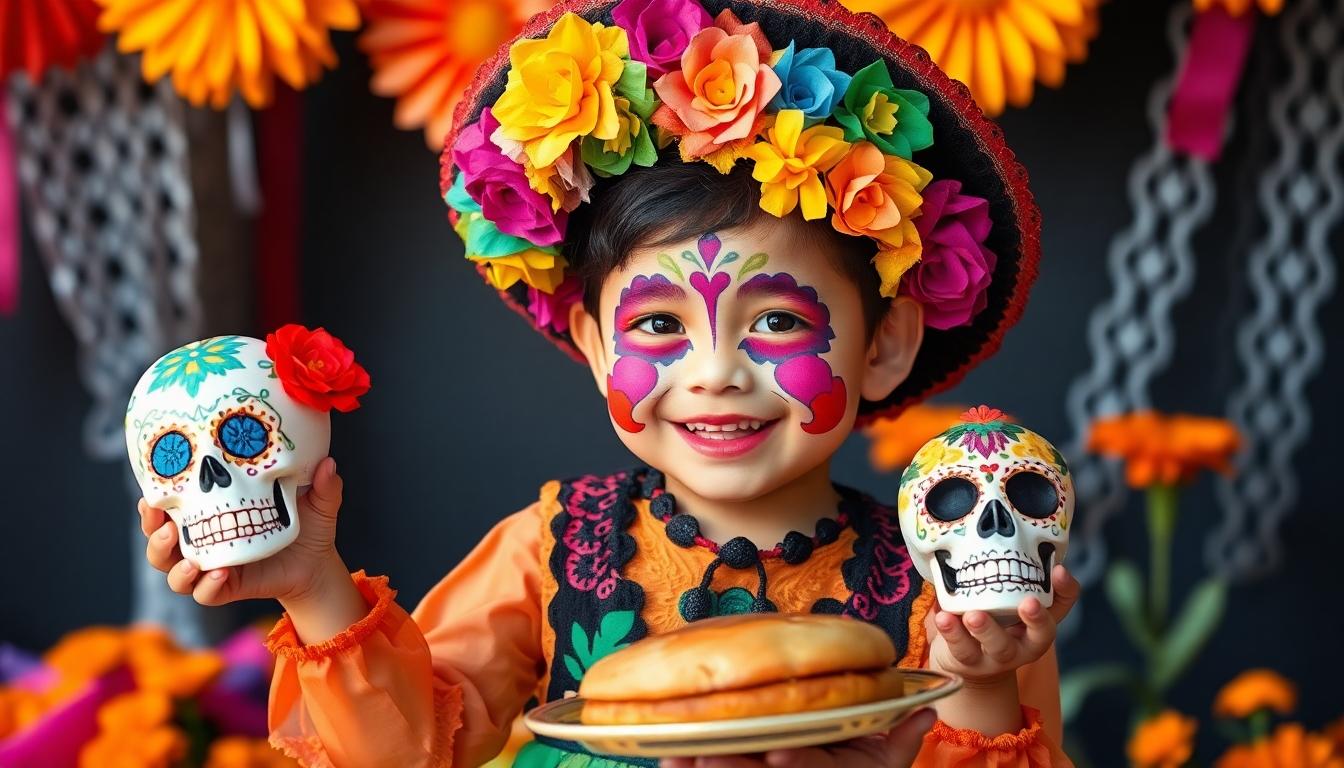
Looking for some kid-friendly humor to share during Día de los Muertos celebrations? These light-hearted jokes capture the festive spirit of the holiday while being appropriate for younger audiences.
Candy Calavera Quips
Kids love sweet treats, and these sugar-coated jokes will have them giggling while learning about Day of the Dead traditions:
- What do bakers give people on Día de Muertos? Flours!
- What kind of sweet is never set out for the ofrendas on time? ChocoLATE!
- Why does everyone need Pan de muerto on Day of the Dead? Because loaf makes the industry go round!
- Why was the Pan de muerto late for Day of the Dead? It wasn’t a quick bread!
Family-Friendly Fiesta Funnies
Share these jokes at your family celebration to keep the mood festive and fun:
- Why did the skeleton go to the party? To have a bone-tastic time!
- Why didn’t the skeleton go looking for calaverita? Because he had no “body” to go with!
- What type of road do skeletons like to roam during Día de Muertos? Dead Ends!
- What do you call someone with garlic breath on the Day of the Dead? Bonely!
- What do you clean up Day of the Dead pots and pans with? Bone-ami!
Ofrenda Humor: Jokes About Day of the Dead Traditions

Day of the Dead traditions offer rich material for humor that respects the celebration while adding levity to remembrance rituals. These jokes cleverly incorporate the symbolic elements found on ofrendas (altars) and throughout the festivities.
Altar Ego Comedy
Altars are central to Day of the Dead celebrations, making them perfect subjects for playful punchlines. Skeletons feature prominently in these jokes, bringing spiritual humor to the forefront of festivities. “What’s a skeleton’s favorite holiday drink? Anything with a little spirit!” captures the playful connection between the spiritual industry and celebrations. Traditional satirical verses known as calaveras add another dimension to Día de los Muertos humor. These witty compositions humorously critique the living while acknowledging death’s inevitability. Skull jokes particularly shine in altar humor, with quips like “Why do sugar skulls always get invited to the fiesta? They’re the life of the altar!” Playing with the contrast between death imagery and lively celebrations creates perfect comedic tension that honors both aspects of this meaningful holiday.
Marigold Path Punchlines
Marigold flowers create the vibrant pathways that guide spirits home during Day of the Dead, inspiring many jokes about spiritual navigation. “How do spirits find their way back home on Day of the Dead? With marigold GPS!” highlights the important role these bright orange blooms play in the celebration. Floral humor blooms with jokes such as “Why did the skeleton bring marigolds to the party? He wanted to bloom in the afterlife!” These punchlines celebrate the symbolism of marigolds while maintaining the celebration’s lighthearted spirit. Pathway jokes connect the living and dead worlds through humor, acknowledging the temporary bridge created during this special time. Creative marigold wordplay reminds us of the beautiful tradition of creating flower trails to welcome ancestors back for their annual visit.
Cultural Celebration Chuckles: Respectful Day of the Dead Wordplay
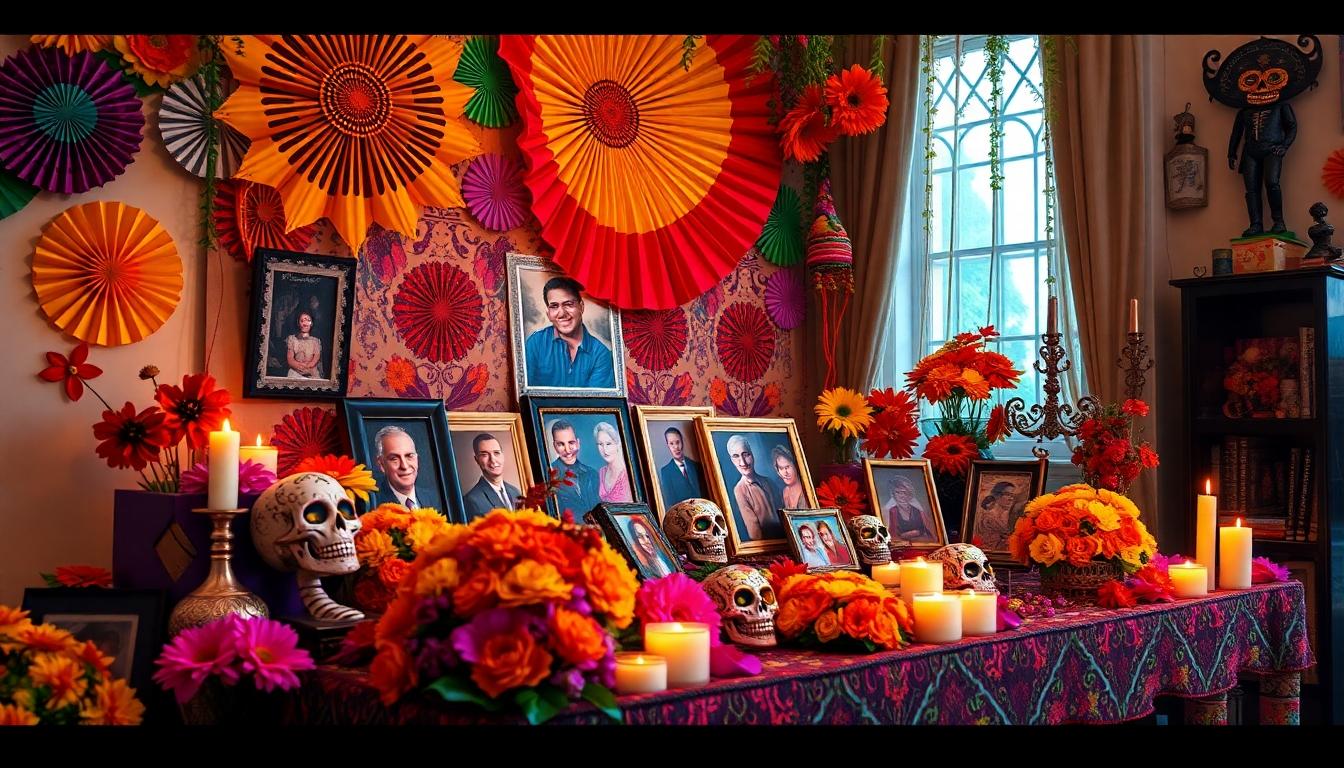
Day of the Dead humor centers around satirical verses called calaveras literarias that playfully address mortality while maintaining cultural reverence. These witty compositions blend irony with inevitable themes, creating a unique form of wordplay that honors the dead while bringing smiles to the living.
Spanish-English Crossover Jokes
Bilingual humor thrives in Day of the Dead celebrations, creating delightful linguistic bridges between cultures. Jokes like “Why did the ghost bring pan de muerto? Because he ‘kneaded’ to impress his dead relatives!” showcase clever double entendres that work in both languages. Spanish-English puns offer accessibility to diverse audiences while preserving the holiday’s authentic spirit. Many families create hybrid phrases that play on cultural references such as traditional foods and celebration elements, making the humor inclusive for all generations attending the festivities.
Traditional Celebration Quips
Families often share humorous anecdotes about deceased loved ones during Day of the Dead gatherings, emphasizing the Mexican view that death is simply a continuation of life. Stories like “Abuelo’s still haunting the kitchen—even the chili peppers fear his ghost!” celebrate individuality and legacy through laughter. These personal jokes honor exact traits or memorable quirks of departed family members, creating a sense of their continued presence at the celebration. Satirical verses commonly feature lighthearted critiques of the living, imagining their hypothetical encounters with death, such as “La Catrina came knocking—pack your sweet tooth, she’s claiming you for her candy skull collection!” These playful warnings blend traditional symbolism with contemporary contexts, keeping ancestral traditions vibrant and relevant.
Food-Related Day of the Dead Jokes That Are To Die For

Food plays a central role in Day of the Dead celebrations, making it perfect fodder for humorous takes that honor the tradition while bringing smiles to faces. These culinary quips celebrate everything from traditional pan de muerto to the festive treats that adorn altars.
Pan de Muerto Munchlines
Pan de muerto stands as one of the most iconic foods during Día de los Muertos, with its distinctive bone-shaped decorations making it ripe for wordplay. “Why do spirits love pan de muerto? It’s to ‘die’ for!” This sweet bread not only satisfies the hunger of the living but apparently keeps our ancestors coming back for more each year. “What did the skeleton say to his ancestor? ‘Thanks for the memories, and the tamales!'” The rich, anise-flavored bread serves as both a delicious treat and a perfect punchline in celebrations that balance reverence with revelry.
Festive Food Funnies
The colorful array of foods prepared for Day of the Dead celebrations provides endless material for lighthearted humor. “What’s a ghost’s favorite Day of the Dead dish? Soul-food.” Traditional offerings take center stage in these jokes, highlighting the connection between culinary traditions and spiritual beliefs. “Why do sugar skulls always get invited to the fiesta? They’re the life of the altar!” These decorative treats, with their vibrant colors and intricate designs, add sweetness to both the ofrenda and the jokes shared during gatherings. “What’s a skeleton’s favorite holiday drink? Anything with a little ‘spirit.'” Beverages aren’t left out of the fun, with many families preparing special drinks to honor their departed loved ones and quench the thirst of weary souls making the journey back to visit.
Heavenly Humor: Angel and Saint Day of the Dead Jokes
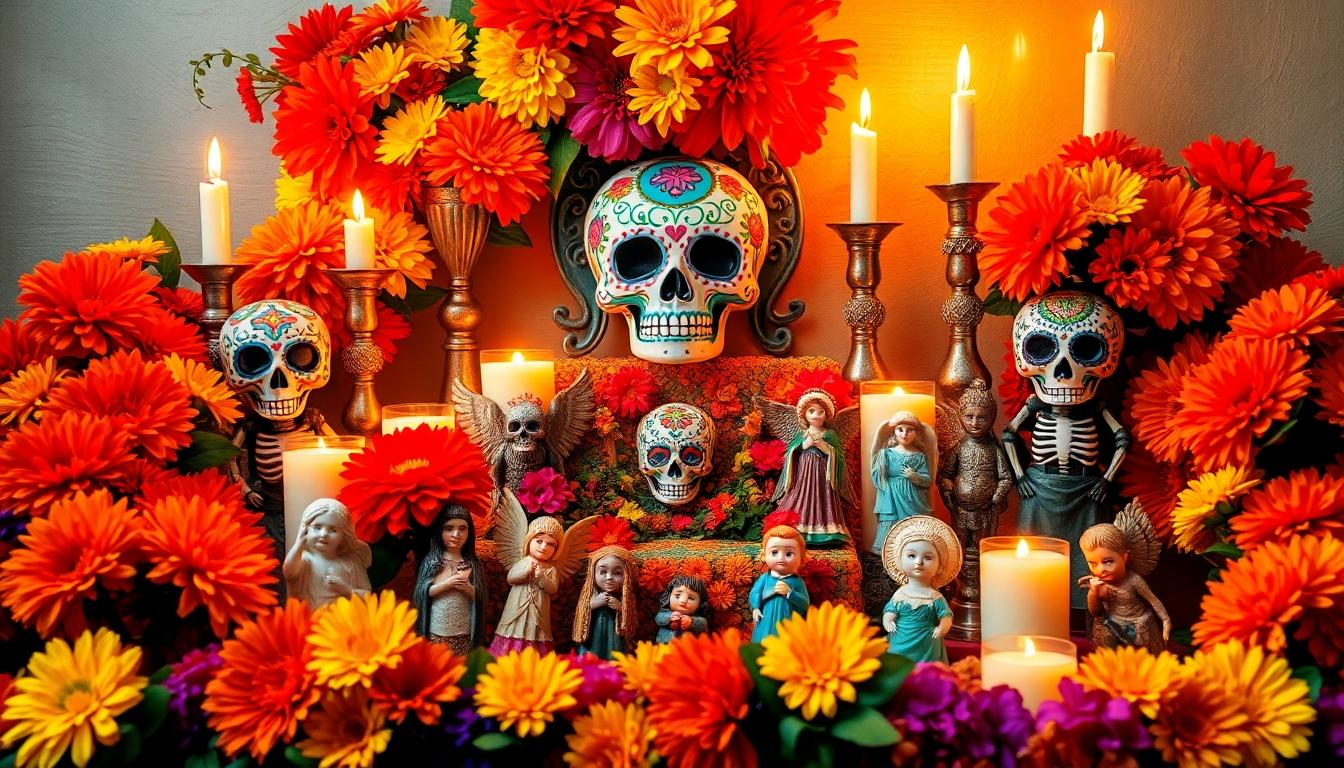
While angels and saints aren’t the most common figures in Day of the Dead humor, they do appear in the celebration’s more celestial jokes. These heavenly figures offer a unique twist on traditional Día de los Muertos comedy, blending spiritual reverence with playful wit.
Divine Comedy
Angels bring a heavenly dimension to Day of the Dead humor with their ethereal presence and divine connections. “Why did the angel bring extra wings to the Day of the Dead celebration? Because they heard it was going to be a ‘spirited’ affair!” jokes like this incorporate the celestial messengers into the festivities while maintaining the celebration’s spiritual essence. Angels often appear in Day of the Dead artwork alongside traditional calaveras, creating a perfect backdrop for humor that bridges the earthly and spiritual realms. Many celebrants appreciate jokes that reference these divine beings as they symbolize protection and guidance for both the living and the souls being honored.
Saintly Silliness
Saints offer rich material for Day of the Dead humor, given their prominent role in Mexican Catholic traditions. “What did Saint Peter say to the skeleton at heaven’s gate? ‘I can see right through you!'” represents the kind of lighthearted jokes that incorporate saintly figures into the celebration. These jokes typically play on the saints’ known attributes or feast days that might coincide with Día de los Muertos. Families sometimes include patron saints in their ofrendas, making saint-themed humor particularly relevant during remembrance gatherings. Traditional calaveras literarias occasionally feature saints in their satirical verses, gently poking fun at religious figures while maintaining respect for their spiritual significance. Saints and skeletons create an unexpectedly humorous pairing in Day of the Dead imagery, highlighting the celebration’s unique blend of reverence and festivity.
Day of the Dead Versus Halloween: Joke Showdown
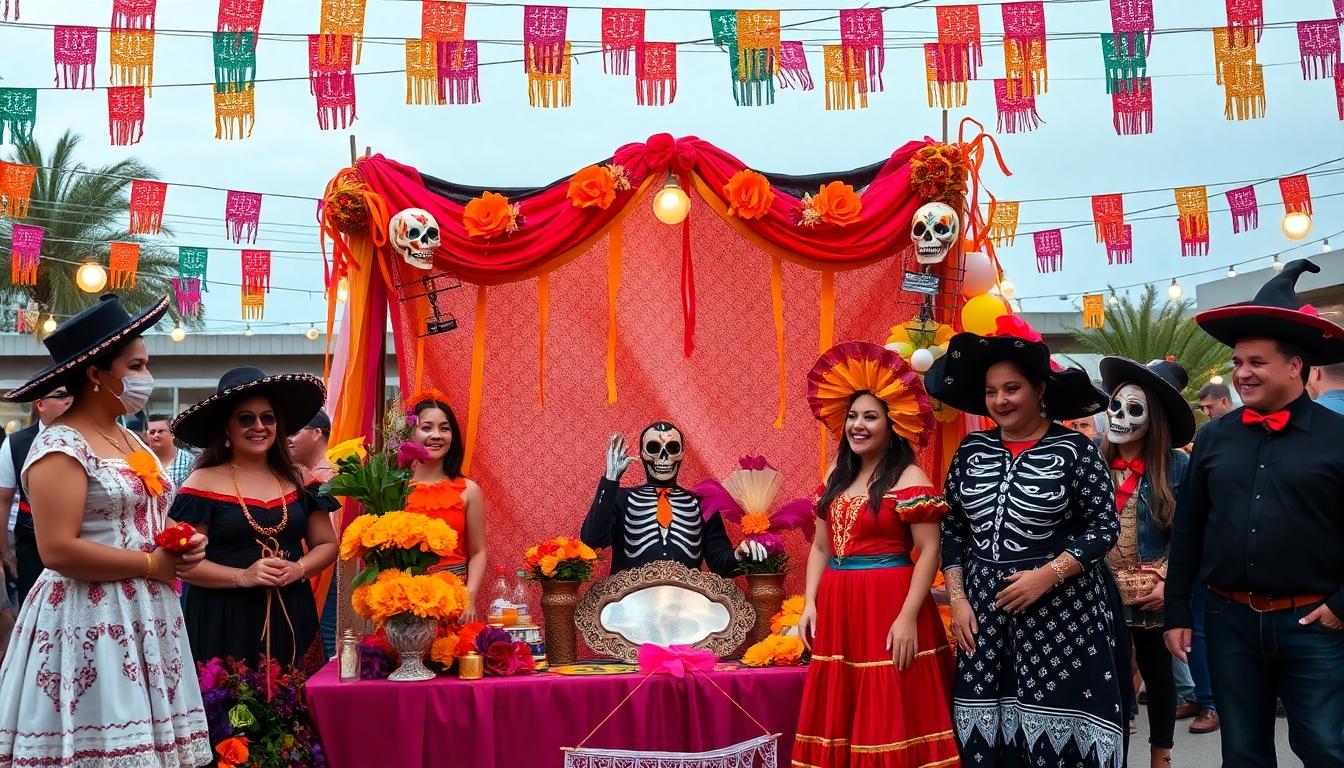
Cultural Contrast Comedies
While both holidays acknowledge death, their humorous approaches couldn’t be more different! Halloween jokes typically lean into spooky themes and supernatural frights, focusing on scary costumes, haunted houses, and playful horror elements. “What’s a ghost’s favorite Halloween candy? Boo-ble gum!” represents the classic Halloween joke style.
Day of the Dead humor embraces a more celebratory approach to mortality, highlighting the vibrant decorations and festive atmosphere. “Why do skeletons never attend Day of the Dead celebrations alone? They don’t have the guts to go solo!” captures this distinctive tone. The colorful imagery of calaveras creates comedic opportunities that contrast beautifully with the holiday’s reverent purpose, turning the somber into something joyful without disrespect.
Holiday Hybrid Humor
Cultural fusion jokes thrive at the intersection of these two celebrations! Imagining Halloween trick-or-treaters visiting a Day of the Dead altar creates instant comedy: “What did the vampire say at the Day of the Dead ofrenda? ‘I came for the food, but I’ll stay for the spirits!'” These crossover scenarios highlight the fundamental differences between fearing death and honoring it.
Misconceptions between the holidays generate plenty of laughs too. “Why was the Halloween ghost confused at the Day of the Dead celebration? Everyone kept inviting him to dinner instead of running away screaming!” This type of humor playfully addresses how Americans often mistakenly view Day of the Dead as “Mexican Halloween” rather than understanding its unique cultural significance. The contrast between Halloween’s jack-o’-lanterns and Day of the Dead’s sugar skulls, or between trick-or-treating and setting up elaborate altars, provides rich material for jokes that educate while entertaining.
Modern Day of the Dead Jokes From Movies and Pop Culture
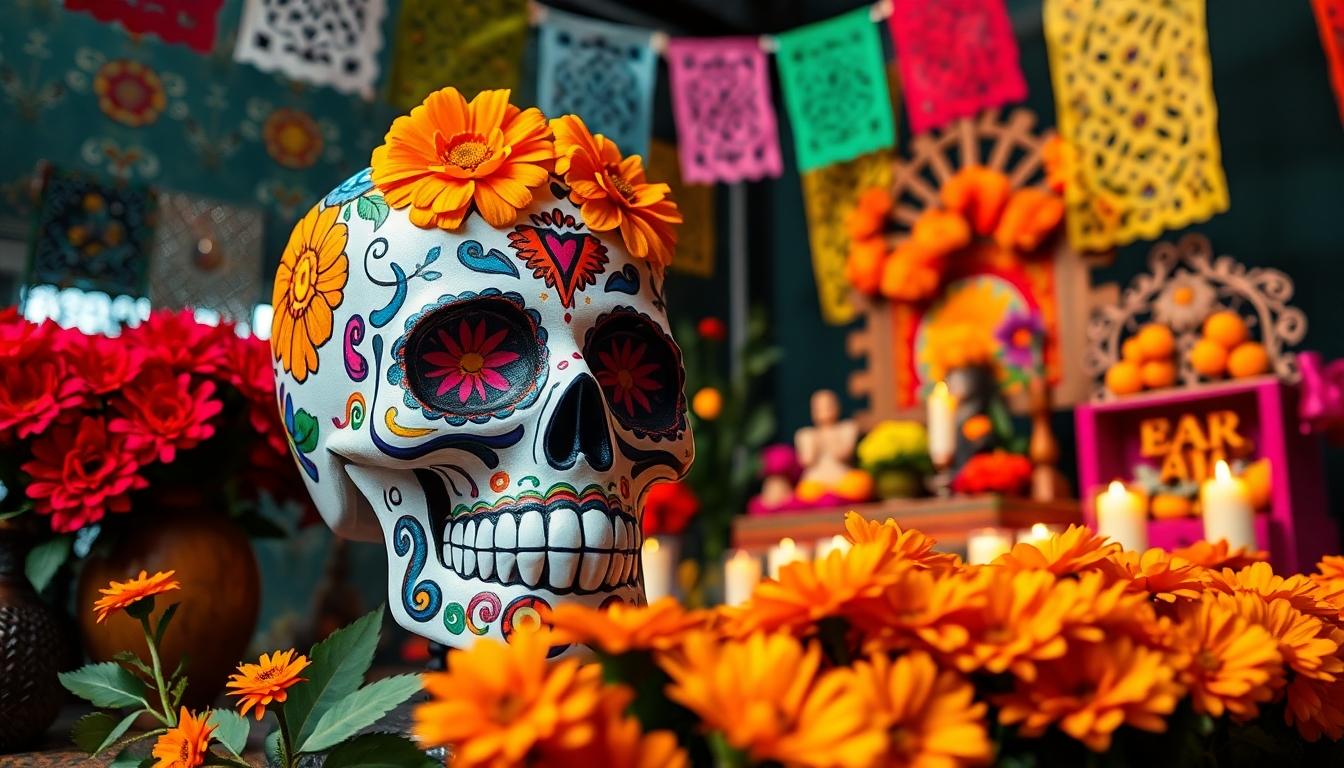
While Día de los Muertos traditionally carries a tone of reverence, modern entertainment and digital culture have embraced the holiday’s colorful imagery with a humorous twist. This fusion of tradition and contemporary wit has created a new category of Day of the Dead humor that resonates across various media platforms.
Coco-Inspired Comedy
Pixar’s Coco has significantly influenced how people approach Day of the Dead humor. Though not primarily a comedy, the film’s warm-hearted portrayal of the afterlife has inspired countless jokes and memes. The vibrant Land of the Dead setting provides rich material for comedic interpretations, with characters like Héctor and Dante becoming frequent subjects of lighthearted jokes. Fans often reference the film’s memorable moments, creating humorous scenarios that play on the movie’s themes of family, memory, and musical passion.
Social Media Memes and Mockery
Social media platforms have become hotbeds for Day of the Dead humor, with users sharing witty content that celebrates the holiday’s distinctive aesthetic. Popular jokes include classics like “I’m dying to celebrate Día de los Muertos” and “Why did the sugar skull go to the party? To get its sugar fix!” These humorous takes typically incorporate traditional elements such as calaveras, marigolds, and elaborate altars in unexpected ways. Platforms like Instagram, TikTok, and Twitter feature countless creative interpretations that blend cultural appreciation with contemporary comedy styles. The colorful imagery of sugar skulls and skeleton decorations provides perfect visual material for meme creators looking to celebrate the holiday with respect while adding a touch of humor.
The Serious Side: How Humor Helps Honor the Dead
Day of the Dead jokes offer more than just laughs—they’re a meaningful bridge between grief and celebration. Through skeleton puns and ofrenda humor we’ve explored how comedy reinforces cultural connections while lightening the weight of remembrance.
These jokes aren’t disrespectful but rather celebrate life’s continuity. Whether sharing bilingual wordplay at family gatherings or chuckling over sugar skull sweetness with children the humor brings generations together in honoring loved ones.
We hope these jokes bring smiles to your Día de los Muertos celebrations. Laughter alongside reverence creates the perfect blend that makes this tradition so special—a reminder that even in death our loved ones continue to bring joy into our lives.
Frequently Asked Questions
What is Día de los Muertos?
Día de los Muertos (Day of the Dead) is a Mexican holiday celebrated on November 1-2 that honors deceased loved ones. Unlike Halloween, it’s not meant to be scary but rather a celebration of life and death. Families create ofrendas (altars) with photos, food offerings, and marigold flowers to welcome back the spirits of their ancestors for a joyful reunion.
Is it disrespectful to joke during Day of the Dead celebrations?
No, humor is actually an integral part of Día de los Muertos. The celebration embraces a balance between reverence and joy. Lighthearted jokes, especially those featuring skeletons (calaveras), honor the holiday’s perspective that death is a natural part of life. The key is ensuring jokes celebrate the festive atmosphere while maintaining respect for the cultural significance.
What are calaveras literarias?
Calaveras literarias are satirical poems or verses written during Day of the Dead. These humorous, mock-obituary poems playfully “roast” the living as if they were already dead. They represent the Mexican tradition of facing mortality with humor rather than fear. These witty compositions often critique politicians, celebrities, or friends while incorporating cultural references to death and the afterlife.
How do Day of the Dead jokes differ from Halloween humor?
Day of the Dead jokes celebrate mortality with bright colors and festivity, while Halloween humor tends to focus on scares and spooky elements. Día de los Muertos jokes often feature skeletons engaging in everyday activities, food puns about traditional offerings, and playful references to the afterlife. They reflect the holiday’s perspective of death as a natural continuation of life rather than something frightening.
What role do skeletons play in Day of the Dead humor?
Skeletons (calaveras) are central figures in Day of the Dead humor because they represent the departed in a non-threatening way. Jokes often depict them engaging in human activities—dancing, eating, playing music—which reflects the holiday’s view that death is another state of being, not an end. Skeleton puns and wordplay (like “bone-afide” or “no body to dance with”) are particularly popular.
Are there Day of the Dead jokes appropriate for children?
Yes! Many Day of the Dead jokes are family-friendly and perfect for children. Kid-appropriate jokes often focus on sugar skulls, traditional foods like pan de muerto, or gentle skeleton humor. Examples include “What do bakers give people on Día de Muertos? Flours!” or “Why did the skeleton go to the party? To have a bone-tastic time!” These jokes introduce children to the celebration’s themes in an accessible way.
How has the movie “Coco” influenced Day of the Dead humor?
Pixar’s “Coco” has significantly popularized and expanded Day of the Dead humor globally. The film has inspired countless jokes and memes featuring characters like Héctor and Dante. It’s introduced audiences to cultural elements like spirit guides, marigold bridges, and family remembrance, generating new humor that crosses cultural boundaries while still honoring the holiday’s core themes of family connection and remembrance.
What are common themes in Day of the Dead jokes?
Common themes include skeleton wordplay (“bone” puns), food humor about traditional offerings, marigold path references, musical jokes about skeletal mariachi bands, and afterlife scenarios. Many jokes playfully connect the living and dead worlds or feature ancestors returning for the celebration. Bilingual wordplay that mixes Spanish and English is also popular, reflecting the celebration’s cultural roots.
Why are food jokes popular during Day of the Dead?
Food is central to Day of the Dead celebrations, with special dishes prepared as offerings on ofrendas. Food-themed jokes playfully reference traditional items like pan de muerto (“bread of the dead”), sugar skulls, and favorite dishes of the deceased. Puns like “Why do spirits love pan de muerto? It’s to ‘die’ for!” celebrate the culinary traditions while maintaining the holiday’s lighthearted approach to mortality.
How has social media affected Day of the Dead humor?
Social media has globalized Day of the Dead humor, allowing for wider sharing of jokes, memes, and visual puns across platforms. These digital spaces have created new fusion humor that blends traditional elements with contemporary references. Instagram-friendly calavera makeup tutorials often include skeleton jokes, while TikTok features humorous Day of the Dead skits that educate and entertain, helping preserve the tradition while adapting it to modern contexts.







